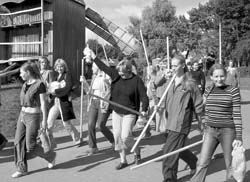An Unpaid Workday on Friday: the Unemployed Clean Up Architectural Monuments

Last Friday morning at the Pyrohiv Open-Air Museum of Folk Architecture was the scene of special activities. Instead of the customary calm and silence, the museum was bustling with about 400 unemployed people from Kyiv, who were enthusiastically cleaning up the compound. Among them were accountants, economists, lawyers, teachers, doctors, as well as metal- and wood-workers. Rakes and axes were quickly distributed, and several semi-gloved persons were seen working near every structure. Others were slogging away with their bare hands. “Idleness is agony,” said Vasyl, explaining his energetic work piling up rocks. In a word, the specter of communism was visibly haunting the open-air Museum of Folk Architecture last Friday.
This Friday event, once known as a subbotnik, was organized by the Cabinet of Ministers, which instructed the city authorities to clean up architectural monuments. The Kyiv Municipal Job Center, which has thousands of jobless people “at its disposal,” decided to help the state tidy up objects of national pride and organized a citywide action to clean up the museum in Pyrohiv. In the morning, buses brought in the volunteers, mostly young educated people, some of whom attend professional upgrading and retraining courses offered at job centers. Arrangements were made with the educational institutions to defer the volunteer workers’ classes. The cleanup effort masks a serious problem: all these young able-bodied people cannot find their place in life. “I came here because there are no classes today,” says a young economist named Oleksiy. “It is very difficult to find a job even if you have education and work experience. Even though I have five years of experience, I can’t find a job. The unemployment level is too high, and employers can afford to be choosy. Sometimes they take an individual on probation who works for a pittance and then is replaced by a new applicant.”
The young man is right: at least in his profession, supply far outstrips demand. About 50% of all vacancies at Kyiv job centers are for blue-collar workers: builders, machinists, salespersons, cooks, barmen, and waiters are in special demand. “When these people come to us, we almost immediately find them a job,” explains Tamara Kharytonova, chief of the employer liaison department at the Kyiv Municipal Job Center. A large proportion of registered unemployed individuals are highly skilled white-collar workers, who are used to earning handsome salaries and working in decent conditions. These people find job-hunting far more difficult. Of course, there are vacancies for economists and lawyers, but there are fewer of them than other types of applicants.
Incidentally, during the past decade Ukrainian educational institutions have been busy turning out lawyers and economists and the labor market is now glutted with them. This practice has seriously upset the balance.
However, the situation in Kyiv hardly reflects the overall picture in Ukraine. Although nationwide unemployment dropped by almost 1.5% in the past year, the official number of the jobless is now 1,732,000. There is an acute shortage of job vacancies: at the beginning of the year there were only 166,500. Creating new jobs is not an inexpensive undertaking. According to economist Demyan Bohynia, who heads the Department of Labor Economy, Demography, and Living Standards at the Institute of Economics (National Academy of Sciences), the cost of a low/medium-technology job is estimated at about UAH 200,000. Should any sophisticated devices be required, a job may cost as much as $200,000. Incidentally, during his election campaign, Viktor Yushchenko promised Ukrainians five million new jobs. At the moment odd jobs, like the cleanup at the Museum of Folk Architecture in Pyrohiv, looks more realistic.






